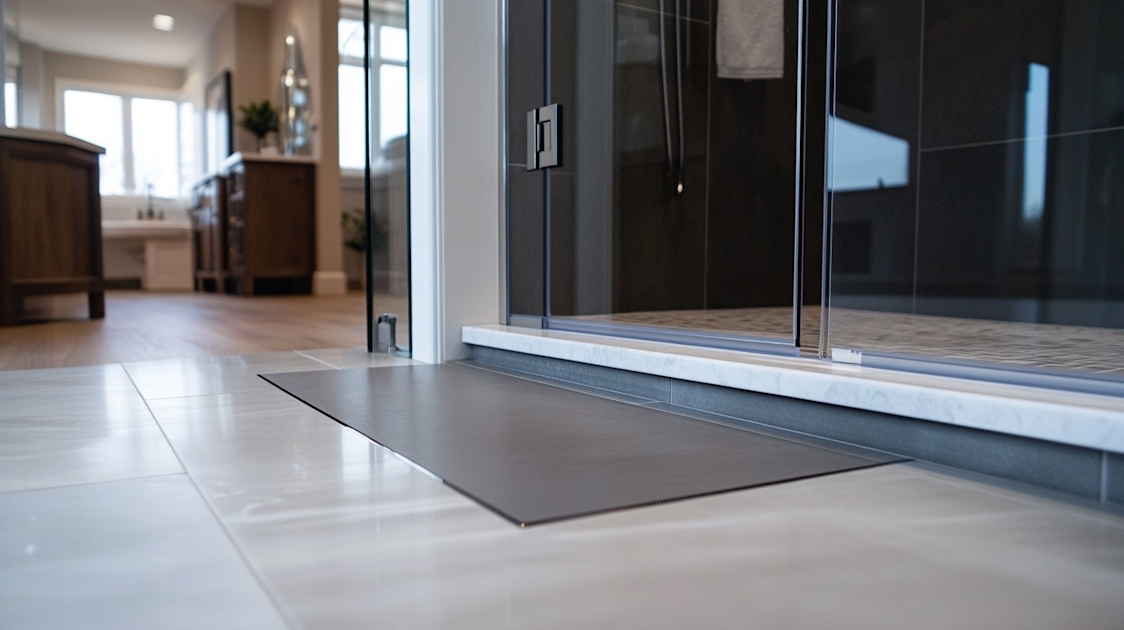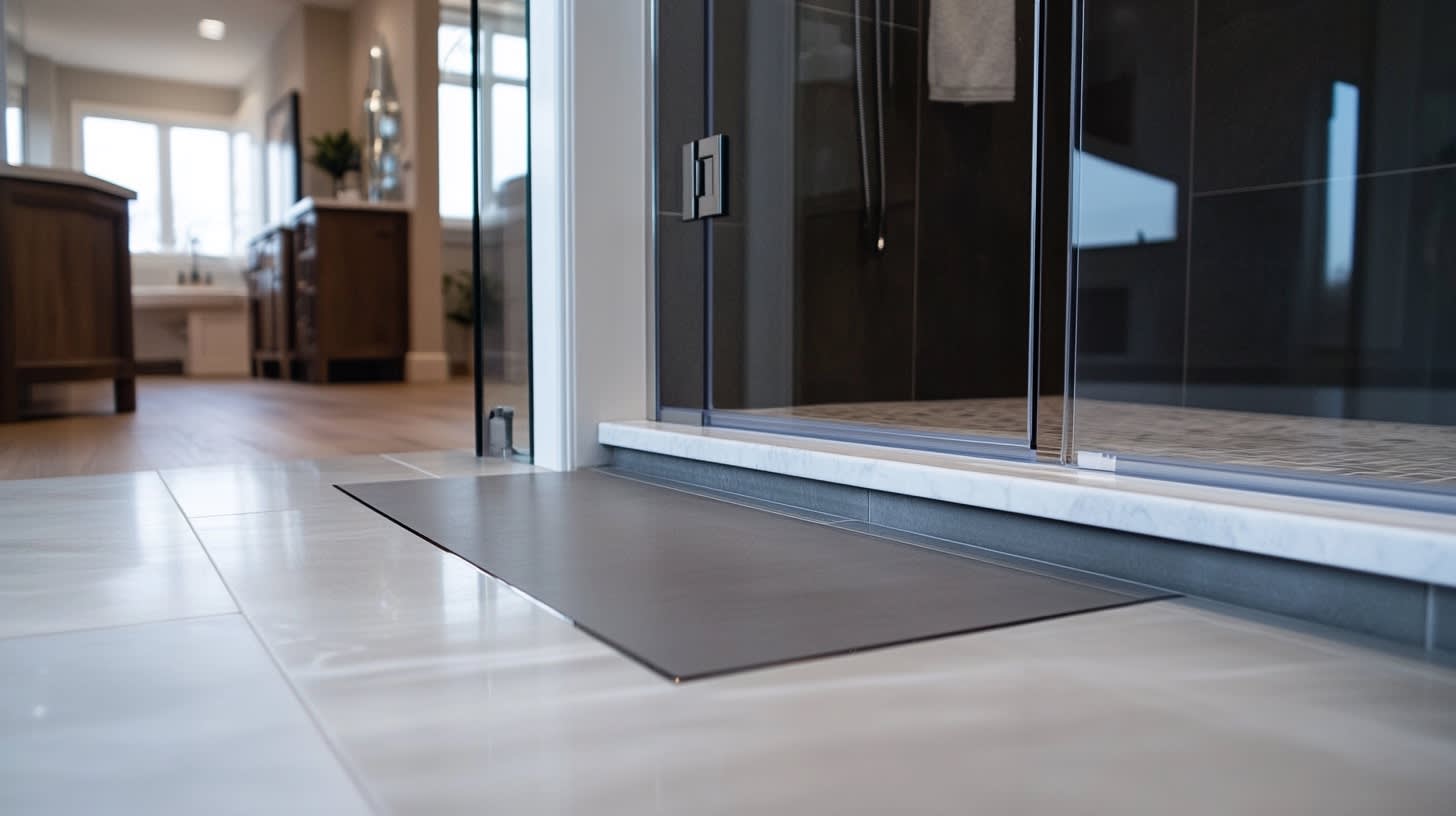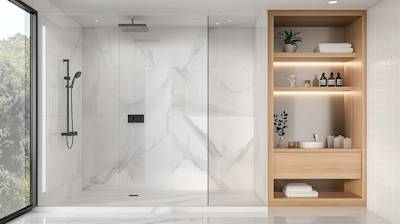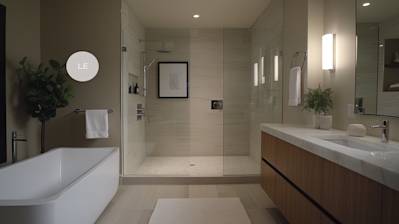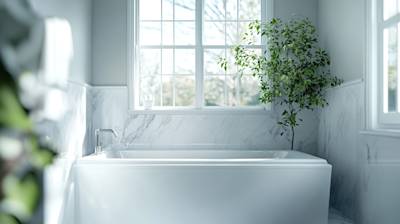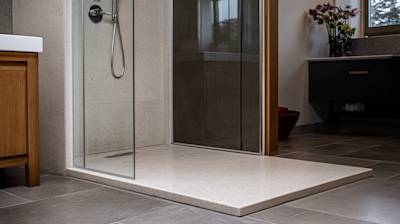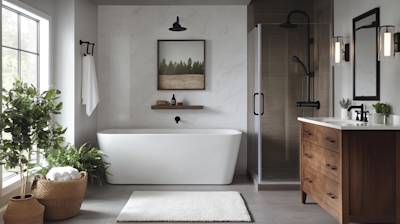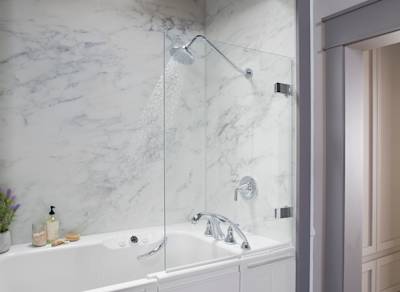Shower thresholds play a critical role in the design and functionality of your bathroom. Although often overlooked, this component serves as the barrier between your shower area and the rest of your bathroom. Thresholds not only prevent water from spilling out of your shower, but also add an aesthetic touch that can significantly enhance the overall look of your bathroom.
In this article, we will delve deep into the realm of shower thresholds, discussing their importance, the best materials to use, and how they can be installed properly.
Why Shower Thresholds Are Important
Shower thresholds are more than just bathroom accessories. They are essential components that contribute to the overall functionality and value of your bathroom. Here are a few reasons why shower thresholds are undeniably important:
-
Preventing Water Leakage: Their primary function is to act as a barrier for water. An appropriately installed shower threshold ensures that all the water remains within the confines of the shower or bathtub.
-
Preventing Slipping: They provide a tactile indicator that you're stepping out of the shower, reducing the chance of slipping on a wet bathroom floor.
-
Increasing Accessibility: Particularly when paired with a walk-in shower design, thresholds can also be lowered to facilitate access for persons with mobility issues.
-
Enhancing Bathroom Décor: While primarily functional, the shower threshold can be an influential element in your bathroom's overall aesthetic.
Best Materials for Shower Thresholds
When it comes to shower thresholds, there's a variety of materials available. Each offers unique benefits in terms of appearance and durability.
-
Marble: Known for its natural beauty, marble is a popular choice. It features unique patterns, and its smooth surface is easy to clean and maintain.
-
Granite: Durable and versatile, granite offers a blend of sophistication and practicality. Granite thresholds are hardwearing and available in a range of colors.
-
Quartz: An engineered stone composed of crushed quartz and resin, this material is celebrated for its due to its durability and aesthetic appeal. Quartz thresholds resist scratch marks and stains remarkably well.
-
Tile: Whether you opt for ceramic, porcelain, or glass, tiled shower thresholds offer countless design possibilities. They are also one of the most affordable options.
Crucial Factors to Consider When Choosing a Shower Threshold
The perfect shower threshold differs for every individual, reflecting unique taste, budget, and bathroom layout. Here are some considerations when choosing the best shower threshold:
-
Material Durability: High-traffic areas demand sturdy materials.
-
Aesthetics: The threshold's color, texture, and finish should complement your bathroom's existing decor.
-
Budget: Options like marble or quartz might not be suitable for budget constraints.
-
Maintenance Requirements: Consider how much time you're willing to invest in cleaning and maintenance.
-
Installation Complexity: Some materials may require professional installation, impacting your budget.
The Right Installation for Your Shower Threshold
Looking to install a new shower threshold? With a little DIY know-how, you could tackle this task yourself. However, it's always wise to consult with a professional if unsure.
-
Measure the Area: Start by accurately measuring the width of your shower entry. This will dictate the size of the threshold you need.
-
Choosing the Best Material: Using the factors mentioned above, choose the material that best suits your needs.
-
Secure the Threshold: Use a strong adhesive to secure the threshold in place. Make sure to let it dry completely before using the shower.
-
Sealing the Threshold: To prevent water damage, use a silicone sealant to seal the edges of your shower threshold.

Frequently Asked Questions about Shower Threshold
How tall should a shower threshold be?
A standard shower threshold should be a minimum of two inches above the drain height. However, this might vary depending on the size and layout of your shower or the specific requirements of your local building codes. It is always recommended to consult with your contractor or read up on your local building regulations before deciding on the height of your shower threshold.
Can the shower threshold match my bathroom aesthetic?
Definitely! The shower threshold can be more than just a practical feature. It comes in a variety of materials such as marble, granite, tile, and even metal. You can choose a style and color that complements your overall bathroom aesthetic.
How is a shower threshold installed?
Shower threshold installation typically requires professional knowledge. After the shower base is set up, the threshold material (a solid piece or multiple tiles) is affixed on top using thinset, a type of adhesive mortar. Once dried, it is then sealed to prevent water leakage.
Can a shower threshold be replaced or altered?
Replacing or altering a shower threshold is possible, but it does take a fair amount of work and is best completed by a professional. The process involves removing the existing threshold carefully, cleaning the area, choosing and cutting a new threshold piece, and then installing and sealing it properly to ensure no water leakage.
Does every shower require a threshold?
Not necessarily. While standard showers usually do require a threshold, walk-in showers designed for handicapped or elderly individuals often do not have a threshold to allow for easy access, especially with wheelchairs. These showers are designed to effectively drain water without needing a barrier.
How do I maintain a shower threshold?
Maintenance typically depends on the material of your shower threshold. Regular cleaning can be performed using mild, non-acidic soap solutions. In the case of grout lines or seams, regular sealing (once in a year or two) is advised to prevent water uptake and molding.
Pros of Shower Thresholds
Improved Water Containment
Shower thresholds, typically a small raised section at the base of your shower entrance, are notably effective at containing water within the shower area. Without these barriers, water might easily seep out from the shower to the bathroom floor. Thresholds help confine the water, preventing it from causing potential damage or turning the rest of your bathroom into a slippery hazard zone.
Increased Safety
Thresholds are essential in reducing slip hazards in your bathroom. In creating a barrier for water, they also provide a clear line of demarkation between the wet and dry areas of the bathroom. Those stepping out of the shower onto a dry surface are less likely to slip and fall, improving the safety aspect.
Enhanced Shower Experience
Shower thresholds can also contribute positively to your overall showering experience. There's something truly comforting in knowing that you won't be stepping into a pool of water when you step out of the shower. Particularly in colder months, a shower threshold can reduce the chance of hitting cold, wet tiles with your bare feet - a truly unpleasant experience.
Variety of Design Options
Shower thresholds come in a variety of shapes, sizes, and materials which makes the design possibilities quite vast. You basically have the freedom to choose a threshold that best suits your bathroom aesthetics. Marble, granite, quartz, and even tile are all viable options. Some modern designs even integrate a shower threshold seamlessly into the overall design, making it a subtle yet effective feature.
Cons of Shower Thresholds
Accessibility Challenges
One of the biggest cons associated with shower thresholds relates to accessibility. For those with mobility issues, a tripping hazard is created, making it difficult for them to enter and leave the shower safely. Wheelchair users, seniors, or individuals with injuries may face challenges with even a small threshold. This is one reason why walk-in or zero-threshold showers are often recommended for individuals with such needs.
Installation and Maintenance Issues
Installation of shower thresholds can be complicated and time-consuming. It requires precise measurements and expert installation to ensure effectiveness and longevity. Further, shower thresholds, particularly those made of porous materials like marble or granite, may require additional care and maintenance. These materials are likely to stain, chip, or crack over time and might warrant regular sealing to maintain their appearance and efficacy.
Potential Trip Hazard
Despite their beneficial role in containing water, shower thresholds can introduce an additional trip hazard component to the bathroom, especially for young children and senior adults. Accidentally stumbling over a threshold can result in nasty falls.
Aesthetics May Not Suit All Tastes
While many appreciate the visual appeal of a well-designed shower threshold, others may view it as an unnecessary interruption to the bathroom floor's continuous flow. For some, threshold-free shower designs may be more appealing as they promote a more open and minimalist aesthetic in the bathroom space.
Higher Cost
Last but not the least, adding a shower threshold can increase the cost of bathroom remodeling or construction. The cost can rise further if you choose a high-end material for your threshold, or if you hire a professional for its installation. Homeowners working with a restricted budget might find it difficult to factor in this additional expense.
Myths and Misconceptions About Shower Thresholds
Despite the showers being a common feature in nearly every home, there are numerous myths and misconceptions regarding shower thresholds. There seems to be quite a bit of misinformation about what they’re used for, why they’re important, and even how they should be installed or maintained. Here, we aim to debunk some of the most common myths and misconceptions about shower thresholds.
Myth 1: Any Material Can be Used as a Shower Threshold
One common misconception is that any material can be used as a threshold for showers. This is not accurate. While many materials can indeed be used, it is imperative to use waterproof or water-resistant materials for your shower threshold. Constant exposure to water can degrade certain materials over time and can lead to issues such as mold growth and structural damage. Ideal materials for shower thresholds are generally composed of stone, porcelain, or composite materials specifically designed to resist water.
Myth 1A: Wood is a Suitable Material for a Shower Threshold
One sub-section of the above myth is that wood is a suitable material for a shower threshold. While wood can certainly add a luxurious touch to a shower's design, untreated and unprotected wood can absorb water, warp, and rot over time. If you have your heart set on a wooden shower threshold, make sure that it is properly sealed and treated to withstand the constant exposure to water.
Myth 2: Shower Thresholds are Merely Decorative
Another commonly held myth is that shower thresholds are merely decorative elements. In reality, shower thresholds serve a crucial functional purpose in your bathroom design. They act as a barrier to prevent water from spilling out onto the bathroom floor and causing water damage. They can therefore be a significant safety feature, reducing the risk of slips and falls.
Myth 3: Shower Thresholds are Unnecessary in Modern Design
With the advent of modern, minimalist bathroom designs, some people may be under the impression that shower thresholds are becoming obsolete. This is a misconception. While it's true that some designs strive for a seamless look with level-access or 'barrier-free' showers, a form of threshold is typically still necessary to contain water within the shower area. In these instances, a subtle gradient or a linear drain often serves the purpose of a traditional raised threshold.
Myth 4: The Higher the Threshold, the Better
Many people believe that a higher shower threshold will be more effective at keeping water in the shower. While a sufficiently high threshold can indeed keep water from spilling out, an excessively high threshold could potentially be a tripping hazard. Furthermore, it could cause accessibility issues for individuals with mobility challenges. The aim should be to strike a balance between functionality, safety, and accessibility.
Myth 5: Installing a Shower Threshold is a DIY Project
While shower thresholds might seem like simple structures, installing them requires precision and expertise. Proper installation ensures the threshold is effective in keeping water in the shower area and preventing leaks to the lower levels. A professional should ideally handle this task to guarantee correct slope, seal, and overall installation.
Myth 6: All Shower Thresholds are Cold to Step On
Many people operate under the assumption that all shower thresholds will be cold to the touch under your feet. However, with the advances we've seen in heated floors, same technology can be applied to a shower threshold. It can be heated just like the shower floor, offering a comfortable transition as you enter or exit the shower.
Myth 7: Shower Thresholds Require Frequent Replacement
A well-maintained shower threshold made of durable, water-resistant material should last for many years. While it may require occasional re-sealing to maintain its water resistance, full replacement should only be necessary if it becomes significantly damaged or worn.
To sum it up, understanding the significance of the shower threshold, its materials, installation, and maintenance can save homeowners from potential water damage and unnecessary costs in the long run. It's crucial to dispel the myths surrounding shower thresholds, to make informed choices for your bathroom design and renovation projects.
Summary
Showering should always be seen as an experience of comfort. With a shower threshold, this becomes even more so as it functions as a secure barrier to prevent water from spilling out onto your bathroom floor. It offers no interruption to the soothing experience of a warm bath. While it is often overlooked, the shower threshold plays a crucial role in maintaining the safety and cleanliness of your bathroom.
Shower thresholds come in a variety of designs, materials, and even colors to suit any bathroom theme you might have. Beyond the practical benefits, they are also easily customizable. This seemingly insignificant part of the bathroom can become a significant detail that adds to the overall aesthetic. So you’re not just preventing water leaks, you’re also sprucing up your bathroom.
Remember, the key to a great shower experience lies in the details. A shower threshold enhances both functionality and aesthetics. By preventing accidents caused by water spillage and nudging the look of your bathroom up a notch, a shower threshold is a tiny detail with big benefits. It's one of those little things you can't afford to miss in renovating or building your bathroom. A small addition resulting in maximum enjoyment of your home.
About GVD Renovations & Remodeling
At GVD Renovations & Remodeling, we pour our hearts into transforming homes in Roseville, CA and beyond. Located in the picturesque city of Roseville, we're a seasoned team of skilled professionals specializing in home renovations, devoted to bringing your renovation dreams to life. Our crew has years of experience under their belts, catering to different tastes and renovation needs. We're recognized for our top-notch workmanship and commitment to excellency. So, whether it's a kitchen remodel, siding installation or bathroom makeover, your house is in trustworthy and capable hands with GVD Renovations & Remodeling.
Tags: bathroom, water barrier, tile installation,



